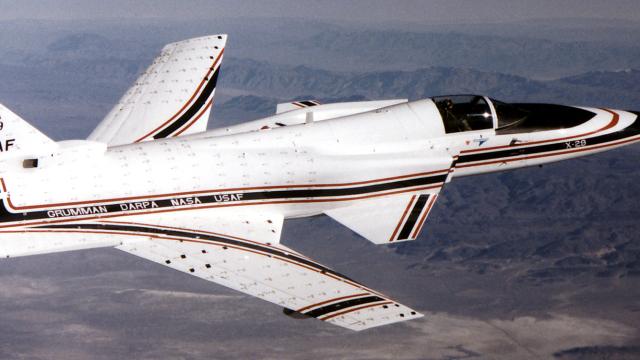The 1980s ushered in more than a few aeronautical revolutions thanks to the emergence of both composite manufacturing techniques and rapidly advancing digital technology. This uniquely designed experimental aircraft integrated all of them into a single system.
The X-29 experimental aircraft, developed by Northrop Grumman in the early 1980’s from the company’s existing F-5A Freedom Fighter platform, was one of America’s first attempts at using forward-swept wings, canard control surfaces (the stubby front wings beneath the canopy that actually control the plane), and fly-by-wire controls. In fact, it was only the third such aircraft with forward-swept wings to actually take to the air — following the Nazi Junkers Ju 287 in 1944 and preceding the HFB-320 Hansa Jet in 1964.
The X-29’s unique wing design was made possible by the advent of composite manufacturing a decade earlier. By constructing the wings and canards from these materials, Grumman engineers were able to both reduce the amount of aeroelastic divergent twisting that hampered the earlier Nazi planes while drastically reducing the weight of the components.
While the forward sweep greatly improved the plane’s agility and offered a maximum attack angle of 67 degrees — compared to, say, the maximum 45 degree angle that an F-15 can pull off. Unfortunately, this added performance came at the expense of overall control of the aircraft, resulting in a severely unstable flight envelope. To compensate, the X-29 relied on a newfangled fly-by-wire system that utilized no less than six separate computers.
As NASA’s Dryden Flight Research Center site explains,
The particular forward swept wing, close-coupled canard design used on the X-29 was unstable. The X-29’s flight control system compensated for this instability by sensing flight conditions such as attitude and speed, and through computer processing, continually adjusted the control surfaces with up to 40 commands each second. This arrangement was made to reduce drag. Conventionally configured aircraft achieved stability by balancing lift loads on the wing with opposing downward loads on the tail at the cost of drag. The X-29 avoided this drag penalty through its relaxed static stability.
Each of the three digital flight control computers had an analogue backup. If one of the digital computers failed, the remaining two took over. If two of the digital computers failed, the flight control system switched to the analogue mode. If one of the analogue computers failed, the two remaining analogue computers took over. The risk of total systems failure was equivalent in the X-29 to the risk of mechanical failure in a conventional system.
Only two X-29s were ever produced. The first made its maiden flight in December of 1984 with rockstar test pilot Chuck Sewell at the helm. Four months later, NASA officially adopted the X-29 for further flight testing. The plane set another record a year later, in December 1985, when it became the first forward-swept wing aircraft to ever break the sound barrier during level flight. Over the next decade, NASA put both X-29’s through the ringer, flying them a total of 242 times before retiring the planes in 1991.
While you can still appreciate the aesthetics of the X-29 at the National Museum of the United States Air Force, it’s the construction and control technologies they helped incubate that have become integral components in modern warplanes. [Wiki – NASA – Smithsonian]
